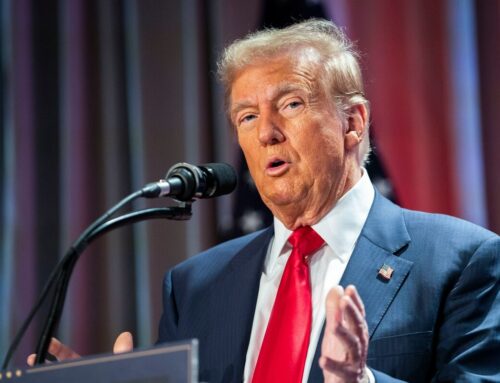Buy, Sell, Or Hold Bitcoin?
December 17, 2024
The price of Bitcoin cryptocurrency (BTC) is likely headed to new highs in 2025 after surging nearly 150% in 2024. Currently trading at nearly $104,000, Bitcoin has eclipsed AI superstar Nvidia in the last 6 months with >55% returns while Nvidia stock barely moved (Sell Nvidia, Buy Intel Stock?). There are reasons to be excited about Bitcoin going into next year considering the political, administrative and market developments. Cryptocurrency has traditionally been regarded as a “speculative” asset with no real contribution to the economy. However, it’s hard to ignore its growing legitimacy, increased adoption, and demand. But, other opportunities exist, too. Up 40% in a week? See What’s Happening With Broadcom Stock?
The OG cryptocurrency crossed $100,000 mark for the first time riding on support from the Donald Trump-led administration. In addition to a shift in regulatory view, notable institution adoption, broader ecosystem developments, limited availability, and global macroeconomic uncertainty could put Bitcoin above $150,000 by the end of 2025. But Bitcoin’s rise hasn’t been without its risks and accompanying volatility. If you want upside with a smoother ride than crypto, consider the High Quality portfolio, which has outperformed the S&P, and clocked >91% returns since inception.
The US Government Has Never Been More Pro-Crypto & Big Players Are All In
Donald Trump’s evolving stance on Cryptocurrency bodes well for Bitcoin’s future. His view toward creating a strategic Bitcoin reserve, and a need for favorable cryptocurrency regulations, is re-vitalizing confidence in the Cryptocurrency. One item on Trump’s presidential campaign agenda was to create a strategic reserve for Bitcoin. While it’s still far from materializing, a concrete bill has already been proposed in the Senate. If passed, it would entitle the Treasury and the Fed to build a reserve of about 5% of the global Bitcoin supply within five years with the purpose of hedging against currency risk, lowering national debt, and supporting the country’s balance sheet. Historically skeptic SEC chair, Gary Gensler, has already decided to step down, which will likely pave the way for crypto-friendly regulations going forward. Moreover, Donald Trump’s team is contemplating creating a dedicated position in the White House to oversee and drive the blockchain ecosystem. These developments will likely work to mitigate risks of investing in a speculative asset, inviting more players into the market – and this is already happening. See What’s Behind The 500% Rise In RGTI Stock?
Growing Institutional investor interest toward Bitcoin is very clear. Bitcoin ETFs have been the most popular in 2024 – a year that saw record new ETF launches. Blackrock iShares Bitcoin Trust ETF has already amassed AUM of $45bn + since its launch in January 2024. As of August 2024, Private Companies and ETFs controlled over 1.2 million units of Bitcoins representing 6.29% of the total supply of Bitcoins. In addition, the cryptocurrency’s holdings of publicly traded companies rose almost 200% year-on-year to ~$20 billion, as of mid-2024.
Bitcoin As A Volatility Hedge
Amid the prevailing geopolitical and macroeconomic uncertainty, Bitcoin is emerging as a lucrative investment option and a hedge against crashing fiat currencies especially in hyperinflationary environments such as in Venezuela, Zimbabwe, and Lebanon. In 2023, Bitcoins made up 9% of Venezuela’s remittances, with crypto adoption further picking up amid oil sanctions. Bitcoin can emerge as a viable hedging instrument for governments as well, with a possibility of central banks diversifying their asset pool with Bitcoin and other Cryptocurrencies. The U.S. and China are already headed that way with other countries likely to follow suit.
The price surge is likely to get a boost from fixed supply and growing demand. This “scarcity” sets Bitcoins apart from conventional fiat currencies. There are only about 21 million coins in existence today, which is essentially all the bitcoins that have been mined. The rate at which new coins are mined drops around the halving events that happen every four years, with the most recent one in April 2024. When the reward to mine new Bitcoin is halved, fewer new coins are mined and added to the pool, thus limiting the supply and driving up prices. In fact, historical trends around halving events have shown a subsequent rise in Bitcoin prices. This year, the price has gone up over 50% since April. Back in April 2020, the price jumped 10x in the one year that followed. Though all the increase cannot be attributed to halving alone, its role is consequential.
So Where Is The Risk?
Since Bitcoin arguably still lacks any intrinsic value, it is susceptible to market sentiment which makes its price volatile. Three years ago, Bitcoin dropped almost 50% twice. First from March 2021 to June 21, and again from Nov 2021 to Jan 2022. Besides, with limited supply of units, the price is potentially open to manipulation by large institutional investors. Cybersecurity threats to stored bitcoins, and potential environmental impact related restrictions also add to the risks involved in this asset class.
There have been numerous periods – such as 2018 and 2022 when bitcoin could not beat the S&P 500. In fact, consistently beating the broader markets — in good times and bad — has been difficult over recent years for individual stocks and even cryptocurrencies. In contrast, the Trefis High Quality Portfolio, with a collection of 30 stocks, has outperformed the S&P 500 each year over the same period. Why is that? As a group, HQ Portfolio stocks provided better returns with less risk versus the benchmark index; less of a roller-coaster ride, as evident in HQ Portfolio performance metrics.
BTC Return Compared With Trefis Reinforced Portfolio
Trefis
Invest with Trefis Market Beating Portfolios
See all Trefis Price Estimates
Search
RECENT PRESS RELEASES
Related Post




